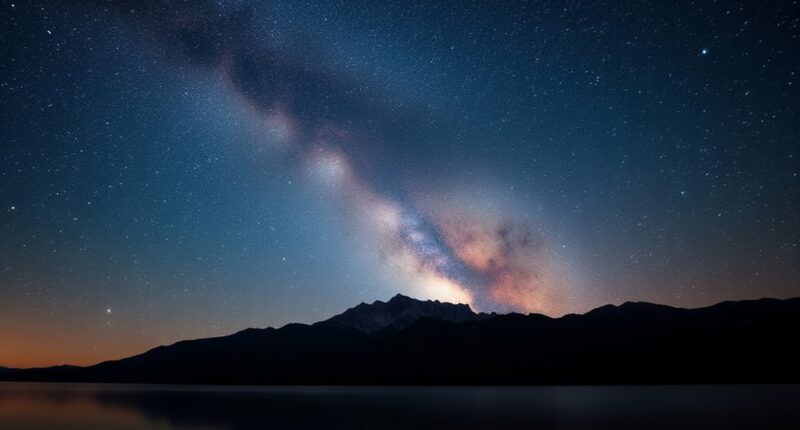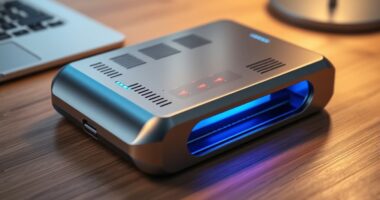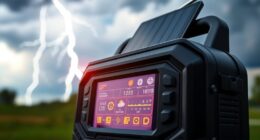If you’re looking for the top astrophotography cameras for stunning night sky shots in 2025, I’ve got you covered. From beginner-friendly options like the ZWO Seestar S30 to advanced sensors like the SVBONY SV715C and versatile devices such as the WiFi Telescope Camera, there are choices for every level. These cameras offer high resolution, low-light performance, and easy connectivity. Keep going, and you’ll uncover the best gear to capture breathtaking celestial images.
Key Takeaways
- The list features versatile cameras suitable for beginners, enthusiasts, and professional astrophotographers, with varying sensor sizes and capabilities.
- High-resolution models like the SVBONY SC715C and Canon EOS Rebel T7 excel in capturing detailed night sky images.
- Portable and user-friendly options such as ZWO Seestar S30 and Dwarf 3 are ideal for outdoor and travel astrophotography.
- Advanced features like low-light sensitivity, high dynamic range, and WiFi connectivity enhance image quality and ease of use.
- The selection includes specialized planetary, deep-sky, and multi-purpose cameras compatible with popular astrophotography software.
SVBONY SV105 Telescope Camera for Astrophotography

If you’re just starting in astrophotography, the SVBONY SV105 Telescope Camera is an excellent choice because it offers simple, plug-and-play operation without the need for complex setup. Its 1/2.8-inch IMX307 CMOS sensor captures bright planets, the Moon, and terrestrial targets with impressive clarity. Recording up to 30 fps at 1080p and 2K videos, it provides detailed images suitable for beginners. The camera’s dark light compensation technology enhances low-light images, and its compatibility with Windows, Linux, and Android makes it versatile. Just connect it, point your telescope, and start capturing stunning lunar and planetary shots effortlessly.
Best For: beginners in astrophotography seeking an easy-to-use, plug-and-play camera for capturing lunar, planetary, and terrestrial images without complex setup.
Pros:
- Simplified plug-and-play operation requiring no driver installation
- High-quality 1/2.8-inch CMOS sensor with 1080p and 2K recording capabilities
- Compatible with Windows, Linux, and Android systems for versatile use
Cons:
- Not compatible with iOS devices like iPhones or iPads
- Limited to bright targets such as planets, the Moon, and terrestrial scenes; less suitable for deep-sky imaging
- May require additional accessories for optimal telescope connection and stability
ZWO Seestar S30 All-in-One Portable Digital Telescope/Camera
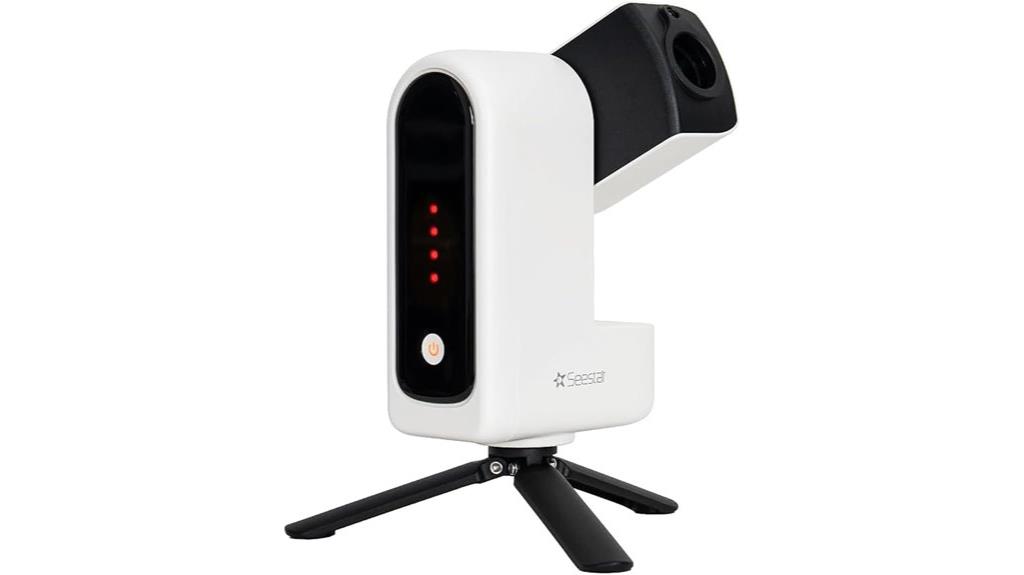
The ZWO Seestar S30 All-in-One Portable Digital Telescope/Camera stands out as an ideal choice for beginner and casual astrophotographers who want to explore the night sky without hassle. Weighing just 3.6 pounds, it’s incredibly portable, making outdoor shoots easy. Its user-friendly Seestar App simplifies star-finding, tracking, and shooting with one tap, removing the complexity often associated with astrophotography. With dual lenses—wide-angle for landscapes and telephoto for distant objects—it supports multiple shooting modes, including deep sky, solar system, and terrestrial scenes. Advanced filters help optimize image quality in various environments, so even in light-polluted areas, you can capture stunning shots effortlessly.
Best For: beginner and casual astrophotographers seeking a portable, easy-to-use telescope with versatile imaging capabilities.
Pros:
- Lightweight and compact at only 3.6 pounds, ideal for travel and outdoor use
- User-friendly Seestar App with automatic star-finding, tracking, and one-tap shooting simplifies astrophotography
- Supports multiple shooting modes and includes advanced filters for high-quality images in various environments
Cons:
- May have limited advanced features compared to larger, professional telescopes
- Dual-lens system might not provide the same image detail as high-end specialized equipment
- Automated features could reduce manual control for experienced astrophotographers seeking customization
Telescope Camera 4K, 8MP Astrophotography Camera

Designed for both amateurs and seasoned astrophotographers, the Telescope Camera 4K, 8MP Astrophotography Camera offers plug-and-play compatibility across multiple operating systems, making setup effortless. It’s recognized automatically by Windows 10/11, macOS 12+, and Linux via USB, with no drivers required. Compatible with standard 1.25″ focusers and featuring an M28.5×0.6mm threaded interface, it supports third-party astronomy software for advanced processing. Its 8MP high-speed sensor captures stunning 1080P@60fps video and 4K footage at 30fps, ideal for lunar, planetary, and deep-sky imaging. Its ultralight, durable aluminum design guarantees stability during long observation sessions.
Best For: amateur and professional astrophotographers seeking a versatile, easy-to-use camera for lunar, planetary, and deep-sky imaging across multiple operating systems.
Pros:
- Plug-and-play with automatic recognition on Windows, macOS, and Linux, no drivers needed.
- High-resolution 8MP sensor with 1080P@60fps video and 4K recording for detailed imaging.
- Lightweight, durable aluminum body with compatibility for standard telescope focusers and third-party software.
Cons:
- May require additional adapters for non-standard telescope focusers.
- Limited to USB connectivity; no wireless or battery-powered options.
- Advanced features might need third-party software familiarity for optimal use.
Dwarf 3 Smart Telescope, Portable with 4K Auto-Tracking
For travelers and outdoor enthusiasts seeking a lightweight yet powerful tool, the Dwarf 3 Smart Telescope stands out with its ultra-lightweight design and portability. Weighing just 3 pounds, it easily fits into a standard backpack, making spontaneous stargazing and outdoor adventures effortless. Its compact size doesn’t compromise performance—thanks to a dual imaging system that captures stunning day and night scenes. The telescope’s smart auto-tracking with 4K resolution keeps celestial objects steady, ensuring clear, sharp images. Plus, cloud-powered processing quickly enhances photos via the DWARFLAB app, making it perfect for both beginners and experts on the go.
Best For: outdoor enthusiasts, travelers, and amateur astronomers seeking a portable, easy-to-use telescope with advanced imaging and auto-tracking capabilities.
Pros:
- Ultra-lightweight and compact design for effortless portability and travel convenience
- Dual imaging system offering versatile day and night photography options
- Smart 4K auto-tracking ensures sharp, steady images of celestial and moving subjects
Cons:
- May have limited zoom compared to larger, professional telescopes
- Requires smartphone or device with the DWARFLAB app for full functionality
- Battery life may be restricted during extended outdoor use
4K Wireless Telescope Camera with IR Filter & X16 Zoom

If you’re serious about capturing clear, detailed images of the night sky, the K Wireless Telescope Camera with IR Filter & X16 Zoom stands out as an excellent choice. Its 8MP CMOS sensor supports 4K video recording and can produce images up to 64MP, even in low light, thanks to advanced compensation technology. The rotatable 2.8-inch IPS screen offers real-time viewing with high color accuracy, and WiFi connectivity within 32 feet allows remote viewing on two devices simultaneously. Compatible with various eyepieces, it’s versatile for telescopes, binoculars, or microscopes. Powered by a rechargeable battery and supporting up to 512GB microSD cards, it’s perfect for outdoor astrophotography and exploration.
Best For: outdoor astrophotographers, wildlife observers, and amateur astronomers seeking high-resolution, versatile imaging capabilities.
Pros:
- Supports 4K video recording and captures images up to 64MP for detailed visuals
- Compatible with various eyepieces and devices via WiFi and universal locking groove
- Long-lasting with rechargeable battery and large microSD storage support up to 512GB
Cons:
- Requires WiFi connection within 32 feet, which may limit remote usability in larger areas
- May have a learning curve for beginners unfamiliar with app controls and device setup
- Limited to 2 devices viewing simultaneously, which could restrict group observations
Smart Telescope with 4K Camera and Dual Screens
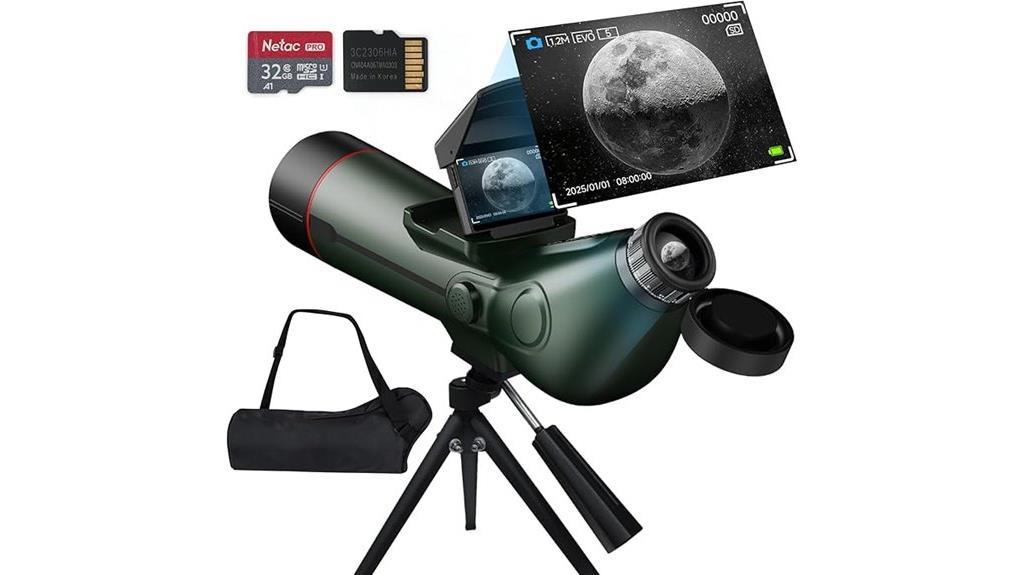
The smart telescope with a 4K camera and dual screens stands out for its seamless integration of high-resolution imaging and real-time observation, making it ideal for both beginners and experienced astronomers. Its 80mm aperture and 300mm focal length deliver bright, clear views, supporting up to 350X magnification for detailed long-distance viewing. The starlight-grade sensor captures stunning 4K images and videos, even in low-light conditions. With adjustable eyepieces, foldable external screens, and a built-in sunshade, it offers personalized, vivid experiences. Its quick photo/video switch, ample storage, and portable design make it a versatile choice for moon gazing, stargazing, and nature photography.
Best For: astronomy enthusiasts, nature lovers, and beginners seeking high-quality, portable telescopic observation and astrophotography.
Pros:
- Supports up to 350X magnification for detailed long-distance viewing
- Captures stunning 4K images and videos even in low-light conditions with a starlight-grade sensor
- Dual screens and adjustable eyepiece for personalized, vivid observation experiences
Cons:
- Limited battery life of approximately 6 hours may require external power for extended use
- The device’s advanced features might have a learning curve for complete beginners
- External storage capacity of 512GB may be insufficient for extensive high-resolution video recordings
SVBONY SC715C Telescope Planetary Camera
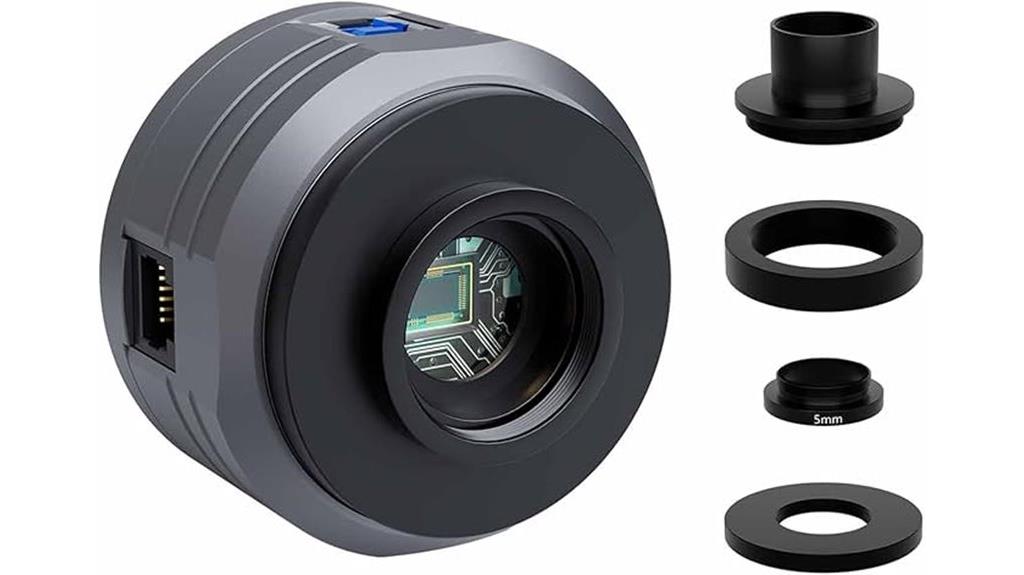
The SVBONY SC715C Telescope Planetary Camera stands out with its high-resolution 4K imaging powered by the 1.45μm IMX715 sensor, making it ideal for capturing detailed images of planets and the night sky. Its high dynamic range and low noise perform exceptionally in low-light conditions, providing sharp, vivid images without the need for a Barlow lens. With USB 3.0 support, it streams at 45.5 fps, ensuring smooth HD video recording. The camera integrates easily with popular software like SharpCap and NINA, and its autoguider interface helps maintain precision during long exposures. Built with durable materials, it’s lightweight and perfect for outdoor astrophotography setups.
Best For: amateur and professional astronomers seeking high-resolution planetary imaging and real-time video capture with easy integration into popular astrophotography software.
Pros:
- High-resolution 4K images with a 1.45μm IMX715 sensor for detailed planetary observation
- Supports high-speed data transfer at 45.5 fps via USB 3.0 for smooth HD video recording
- Durable, lightweight aluminum alloy construction suitable for outdoor astrophotography setups
Cons:
- Requires compatible software; no driver download needed but setup may be complex for beginners
- No built-in Barlow lens support, limiting certain magnification options without additional accessories
- Limited cache size (512MB) might impact performance during very high frame-rate recordings
Canon EOS Rebel T7 DSLR Camera with 18-55mm Lens

For amateur astronomers seeking an affordable yet capable camera, the Canon EOS Rebel T7 DSLR with an 18-55mm lens offers an excellent entry point into astrophotography. It features a 24.1-megapixel APS-C CMOS sensor that captures detailed night sky images, and a DIGIC 4+ processor for fast processing. The 9-point autofocus system and optical viewfinder with 95% coverage make framing shots easier. Built-in Wi-Fi and NFC allow quick sharing, while ISO ranges from 100 to 6400 (expandable to 12800) handle low-light conditions. Supporting Canon EF lenses, it’s versatile enough to grow with your astrophotography skills.
Best For: amateur astronomers and beginner photographers seeking an affordable DSLR with solid low-light and astrophotography capabilities.
Pros:
- High-resolution 24.1 MP APS-C sensor captures detailed night sky images
- Built-in Wi-Fi and NFC for easy sharing and remote control
- Supports Canon EF and EF-S lenses, offering versatility and growth potential
Cons:
- Limited to EF and EF-S lenses, excludes newer EF-M lens compatibility
- Autofocus system with only 9 points may be less effective for fast-moving subjects
- No 4K video recording, only Full HD, which may be a limitation for videographers
WiFi Telescope Camera Eyepiece with 64GB Storage and 1080P Recording
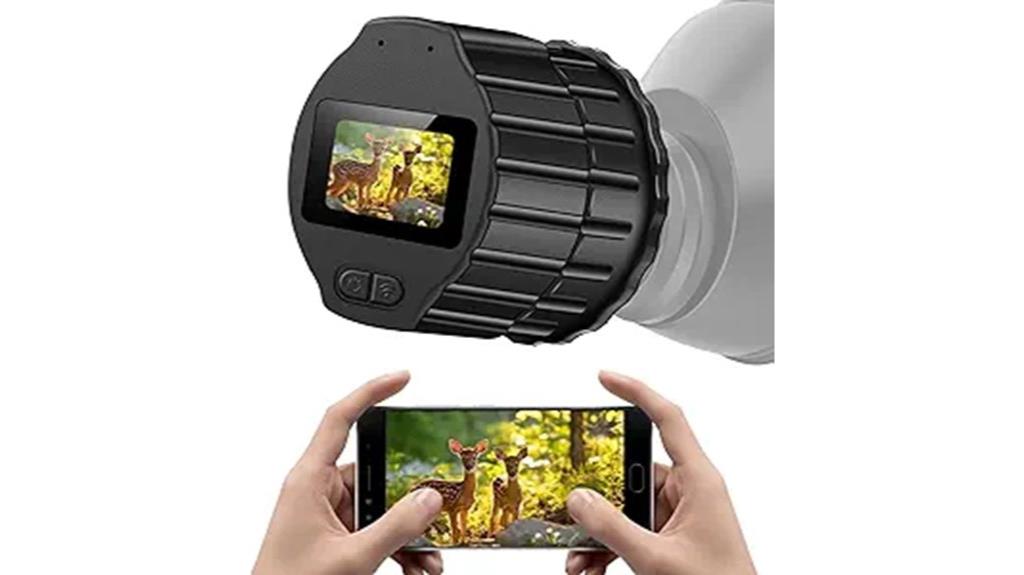
If you’re looking for a portable, easy-to-use device that delivers high-quality astrophotography results, the WiFi Telescope Camera Eyepiece with 64GB storage and 1080P recording is an excellent choice. It features a 1.5″ screen, captures 2MP photos, and records crisp 1080P videos, making it perfect for celestial and wildlife imaging. Compatible with telescopes and microscopes from 28mm to 50mm, it connects easily to your smartphone via Wi-Fi, allowing remote control through an app. Lightweight and compact, it fits in your pocket, perfect for outdoor adventures like stargazing, birdwatching, or hiking. The 64GB storage and long-lasting battery ensure extended sessions without hassle.
Best For: outdoor enthusiasts, astronomers, and wildlife observers seeking portable, high-quality imaging with easy smartphone connectivity.
Pros:
- Compact and lightweight design for easy portability and outdoor use
- High-resolution 1080P video recording and 2MP photo capture for detailed imaging
- Seamless Wi-Fi connection with smartphone app for remote control and sharing
Cons:
- Limited to telescopes and microscopes within 28mm-50mm, restricting compatibility with larger equipment
- Battery life of up to 3 hours may require additional power sources for extended sessions
- Requires enabling network permissions and app setup, which might be challenging for some users
Celestron NexImage 20 Solar System Camera
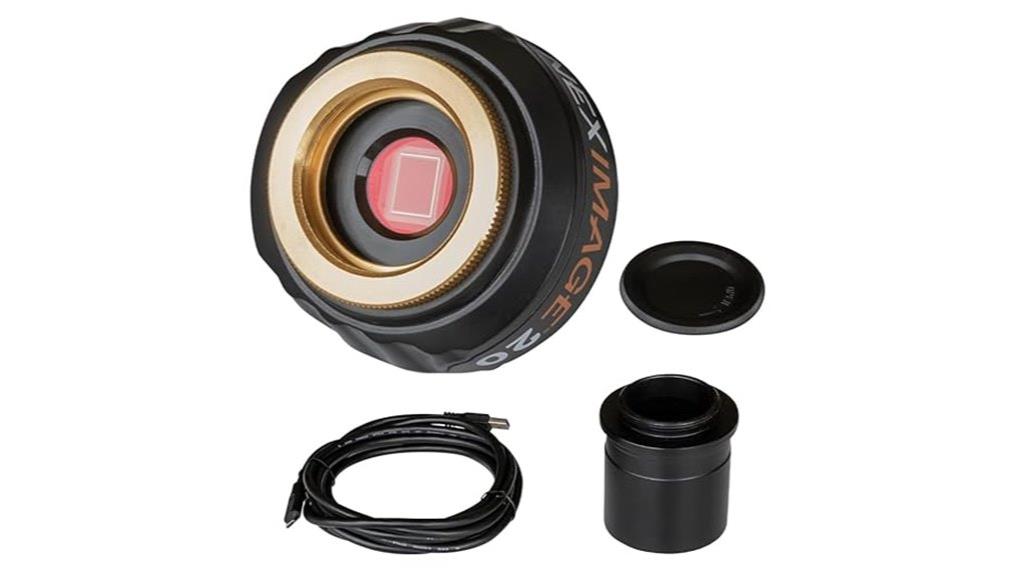
Looking for a camera that delivers quick, high-quality planetary images without complicated setup? The Celestron NexImage 20 Solar System Camera might be just what you need. It connects easily via USB-C, ensuring fast, reliable data transfer with no extra adapters required. Its 20 MP CMOS sensor captures crisp lunar, planetary, and solar details, even in average seeing conditions. You can crop specific regions to improve frame rates and reduce file size, making stacking faster. Plus, it supports autoguiding for deep-sky imaging. Backed by a 2-year warranty and US-based support, it’s a versatile, user-friendly option for planetary and Solar System enthusiasts.
Best For: amateur astronomers and astrophotographers seeking quick, high-quality planetary imaging with easy setup and reliable performance.
Pros:
- Fast, plug-and-play USB-C connectivity for hassle-free use and reliable data transfer
- High-resolution 20 MP CMOS sensor captures detailed lunar, planetary, and solar features
- Supports ROI cropping for improved frame rates and efficient stacking
Cons:
- Primarily optimized for Solar System targets, less suited for deep-sky imaging without additional equipment
- May require additional accessories for autoguiding or advanced astrophotography setups
- Limited to planetary and Solar System imaging, which might not meet the needs of users interested in deep-sky objects
SVBONY SV305C Astrophotography Camera (2.1MP IMX662)
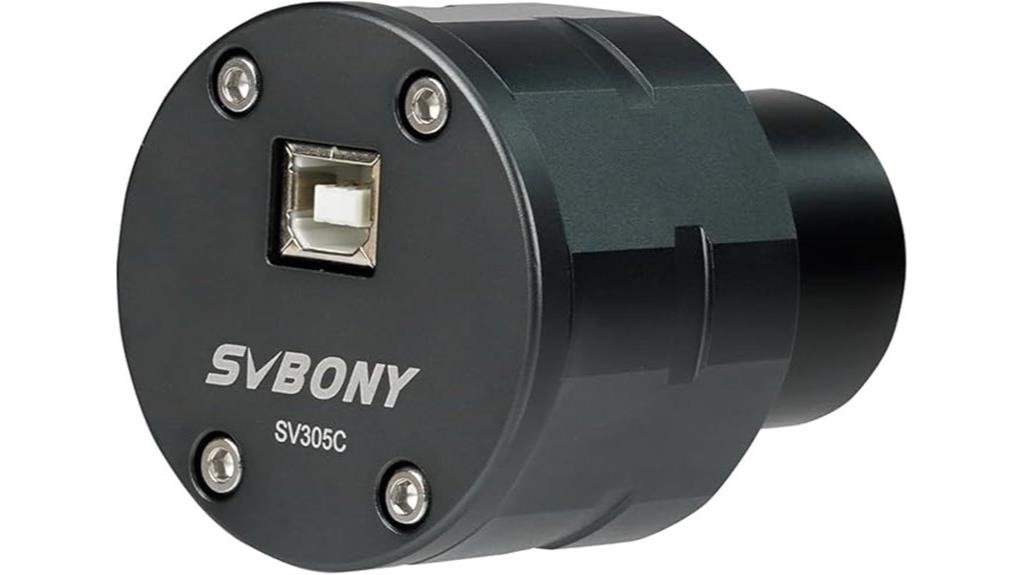
The SVBONY SV305C Astrophotography Camera stands out for its advanced 2.1MP IMX662 sensor, making it an excellent choice for amateur astronomers and astrophotographers aiming to capture detailed night sky images. Its back-illuminated design and 2.9μm pixels enhance light sensitivity, especially in red spectral bands, while low readout noise and no glow improve image quality. The camera offers high-speed planetary and long-exposure sky modes, easily switchable via SharpCap software. Compatibility with 1.25-inch interfaces, C- and CS-mounts, plus noise reduction technology, makes it versatile and user-friendly for capturing everything from planets to deep-sky objects.
Best For: amateur astronomers and astrophotographers seeking a versatile, high-sensitivity camera for planetary, lunar, and deep-sky imaging with easy software integration.
Pros:
- High-quality 2.1MP IMX662 back-illuminated sensor with enhanced NIR sensitivity and low noise
- Multiple imaging modes (high-speed planetary and long-exposure sky) easily switchable via SharpCap software
- Supports a variety of mounting options with 1.25-inch interface, C-mount, and CS-mount compatibility
Cons:
- Non-removable UV/IR cut filter limits customization or removal for specialized imaging
- Limited pixel resolution may not be ideal for very high-resolution astrophotography
- Detachable protective glass could require careful handling to prevent damage
Sky-Watcher Star Adventurer 2i Pro Pack Night Sky Tracker
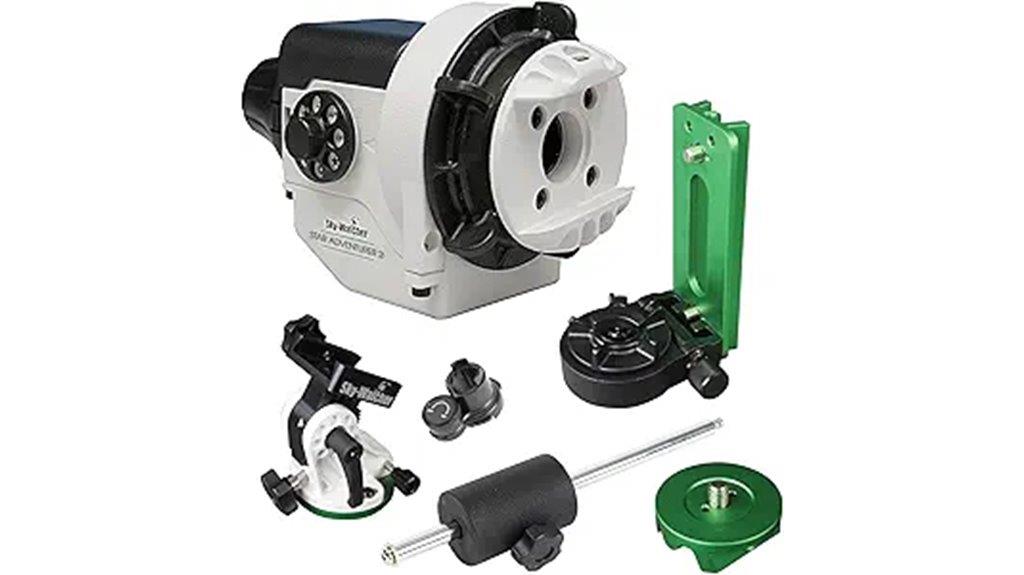
The Sky-Watcher Star Adventurer 2i Pro Pack Night Sky Tracker stands out for its precise motorized tracking, which simplifies astrophotography for both amateurs and enthusiasts. Its compact, modular design easily integrates with standard tripods, making setup straightforward and portable. The tracker supports long exposures, allowing detailed images of the Milky Way, eclipses, and other celestial events. The addition of Wi-Fi and the free SAM Console app means you can control and monitor it remotely via your smartphone. With an upgraded equatorial base for accurate polar alignment, it’s versatile for wide-field shots, time-lapses, and telescopic imaging—perfect for capturing stunning night sky scenes.
Best For: amateur and enthusiast astronomers seeking portable, precise astrophotography and celestial observation with smartphone control.
Pros:
- Compact, portable design for easy setup and transport
- Precise motorized tracking with advanced polar alignment capabilities
- Wi-Fi connectivity and app control for remote operation and monitoring
Cons:
- May require some initial learning curve for optimal polar alignment
- Limited payload capacity for heavier telescopes or accessories
- Dependence on smartphone app could be affected by connectivity issues
WiFi Telescope Camera with 64G Storage and 1.5″ Screen
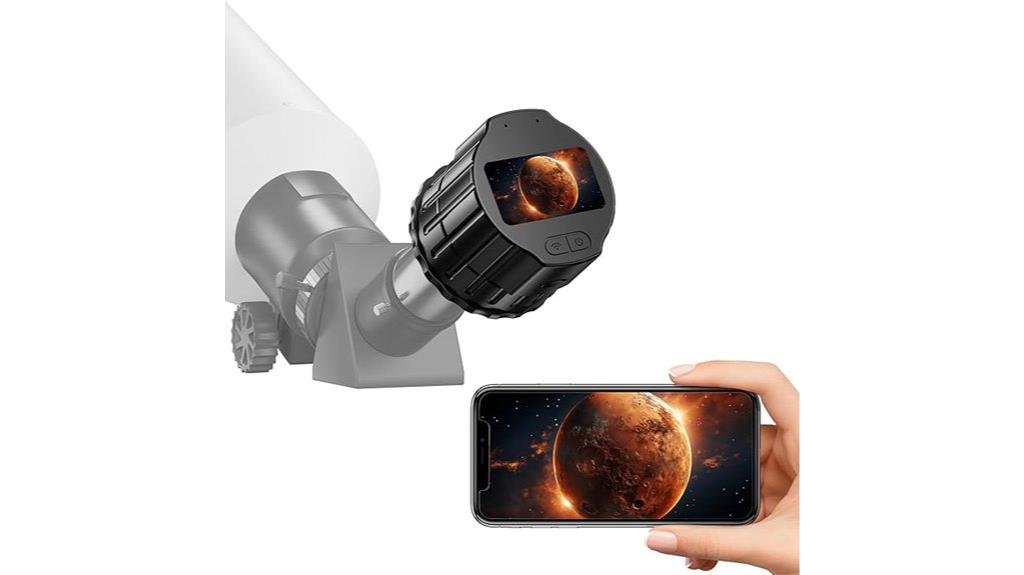
If you’re new to astrophotography or want a portable device that makes capturing celestial wonders easy, the WiFi Telescope Camera with 64G storage and a 1.5″ screen is an excellent choice. Its high-color reproduction 1.5” IPS mini screen makes viewing images intuitive, while WiFi support allows remote observing within 49 feet. Compatible with various scopes, including binoculars and microscopes, it captures 1080P HD videos and 2MP photos with dark light compensation for clear, detailed images. The built-in 1000mAh battery offers about three hours of recording, and the 64G TF card provides ample storage. Easy app integration lets you share your captures instantly.
Best For: astrophotography beginners, wildlife enthusiasts, and nature explorers seeking a portable, easy-to-use camera for celestial and outdoor observation.
Pros:
- High-resolution 1080P HD video and 2MP photos with dark light compensation for detailed images
- Compact 1.5” IPS mini screen for intuitive viewing and easy remote operation via WiFi
- Compatible with a wide range of scopes and supports large storage capacity with 64G TF card
Cons:
- Limited battery life of approximately three hours per charge may require external power for extended use
- Range for remote observing is limited to 49 feet, which might be restrictive in some situations
- Requires WiFi connection and app setup, which may be complex for some non-technical users
SVBONY SV705C Telescope Camera with IMX585 Sensor
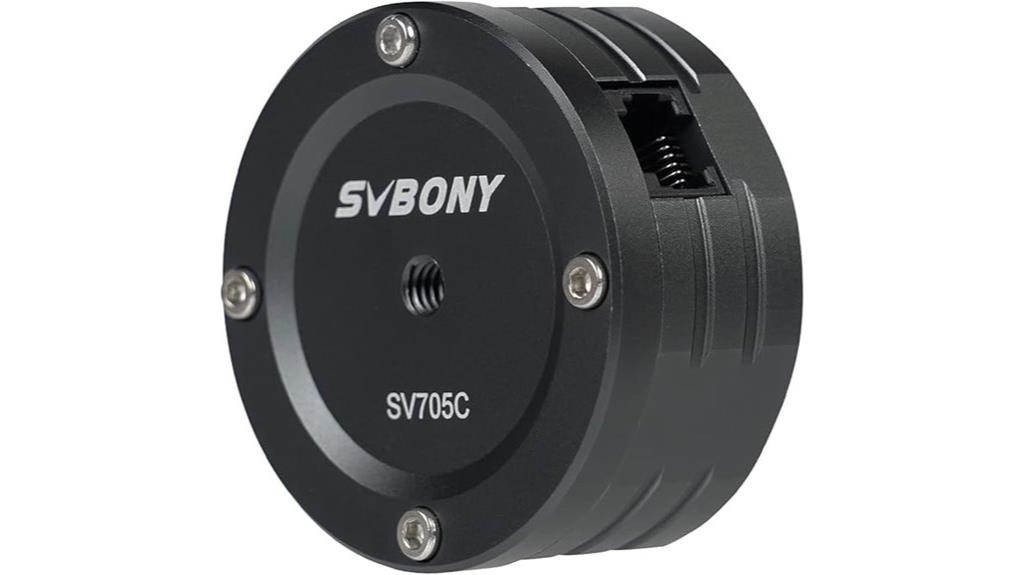
For amateur astronomers and EAA enthusiasts seeking versatile imaging options, the SVBONY SV705C Telescope Camera with IMX585 sensor stands out thanks to its high-resolution capabilities and compatibility with a wide range of lenses. It features a 1/1.2-inch sensor with 3856×2180 pixels, capturing fine planetary details and deep-sky objects. Its back-illuminated design offers up to 90% QE, providing excellent sensitivity and low noise, even at high gain. Equipped with USB 3.0 for fast data transfer and a CS port for lens versatility, this camera is perfect for Moon, planets, and beginner deep-sky astrophotography.
Best For: amateur astronomers and EAA enthusiasts seeking high-resolution planetary and deep-sky imaging with versatile lens compatibility.
Pros:
- High-resolution 3856×2180 pixels sensor captures detailed celestial images
- Back-illuminated IMX585 sensor offers up to 90% QE for excellent sensitivity and low noise
- USB 3.0 interface ensures fast data transfer for efficient imaging sessions
Cons:
- May require additional adapters for optimal lens or telescope compatibility
- Entry-level deep-sky capabilities might be limited compared to specialized astrophotography cameras
- Could be complex for complete beginners to set up and optimize without prior experience
ZWO Seestar S50 Smart Digital Telescope

Designed for both beginners and seasoned astronomers, the ZWO Seestar S50 Smart Digital Telescope stands out with its all-in-one, lightweight design that weighs just 2.5kg. Its compact body combines the telescope, electrical focuser, astronomical camera, ASIAIR, altazimuth mount, and dew heater in a portable package. The professional-grade triplet apochromatic optics deliver crisp, high-quality images while reducing light loss and chromatic aberration. With full app integration, I can easily find, track, and target objects via my smartphone. Its astrophotography capabilities, including image stitching and scheduling, make it a versatile tool for capturing stunning night sky shots effortlessly.
Best For: both beginner and experienced astronomers seeking a portable, all-in-one smart telescope with advanced imaging and automation features.
Pros:
- Lightweight and compact design weighing only 2.5kg for easy portability and setup
- Professional-grade triplet apochromatic optics for crisp, high-quality images and reduced chromatic aberration
- Full app integration with automatic find, track, and target features, plus multiple modes for versatile observation and astrophotography
Cons:
- May have a learning curve for complete beginners unfamiliar with smartphone app controls
- Limited maximum mount height at 363mm, which could restrict viewing angles for taller users
- As an all-in-one device, it might be less customizable compared to traditional modular telescopes
Factors to Consider When Choosing Astrophotography Cameras

When selecting an astrophotography camera, I focus on key factors like sensor sensitivity and size, which affect how well it captures faint stars and details. Resolution and image quality are also vital for sharp, vibrant shots, while ease of use helps me shoot comfortably in the dark. Ultimately, I consider compatibility and low-light performance to guarantee the camera works seamlessly with my gear and performs well in night sky conditions.
Sensor Sensitivity and Size
Sensor sensitivity and size are critical factors that directly influence a camera’s ability to capture stunning night sky images. Higher sensitivity, often measured by quantum efficiency (QE), means the camera can convert more incoming light into digital signals, resulting in brighter, more detailed images. Larger sensors capture more light overall, improving low-light performance and image quality, especially for deep-sky objects. Back-illuminated sensors enhance sensitivity by allowing more light to reach the photodiodes, reducing noise. Pixel size also matters: larger pixels gather more light, boosting clarity in dark conditions. High sensitivity sensors with low read noise and high full-well capacity enable capturing faint celestial details with less noise, making them essential for successful astrophotography.
Resolution and Image Quality
Choosing an astrophotography camera with high resolution and excellent image quality is essential for capturing stunning night sky images. A higher resolution camera captures more detailed images, revealing finer features like planetary surface textures and lunar craters. Image quality relies heavily on sensor size and pixel size—larger sensors and pixels produce clearer, less noisy images, especially during long exposures. The dynamic range of the camera determines how well it can reproduce both bright stars and faint deep-sky objects in one shot, ensuring balanced detail. Low-light sensitivity and back-illuminated sensors further improve clarity in dim conditions, which is vital for deep-sky astrophotography. Additionally, noise reduction features and a high signal-to-noise ratio help deliver sharper, cleaner images, even during extended exposures.
Ease of Use
Ease of use is a critical factor that can make or break your astrophotography experience. A camera with plug-and-play functionality allows me to set up quickly without fiddling with complex drivers or software. Intuitive interfaces or companion apps simplify capturing images, focusing, and tweaking settings, which is especially helpful for beginners. Automatic features like auto-focus, exposure control, and built-in image processing cut down on manual adjustments, making the process more accessible. I also favor lightweight, compact designs that are easy to carry and deploy outdoors, saving time and effort during shoots. Clear instructions and user-friendly controls ensure I can operate the camera confidently without needing extensive technical knowledge. Overall, a camera that’s easy to use keeps me focused on capturing stunning night sky shots rather than battling technical hurdles.
Compatibility Options
When selecting an astrophotography camera, guaranteeing compatibility with your existing equipment and setup is vital for smooth operation. First, check that the camera has compatible mounting interfaces like 1.25-inch, C-mount, or CS-mount to fit your telescope or lens system easily. Next, verify that it supports your operating system—whether Windows, macOS, Linux, or Android—for seamless integration. Compatibility with popular astronomy software such as SharpCap, AstroDMx Capture, or proprietary apps is also essential for effective control and processing. Additionally, consider whether the camera’s sensor size and resolution meet your imaging goals, whether capturing planetary details or deep-sky objects. Finally, guarantee connectivity options like USB 3.0, Wi-Fi, or Bluetooth align with your setup for reliable data transfer and remote operation.
Low-Light Performance
Ensuring your astrophotography camera performs well in low-light conditions is key to capturing stunning night sky images. The main factor here is sensor sensitivity, often measured as ISO or gain, which determines how well the camera detects faint celestial objects. Back-illuminated sensors are a big plus, as they allow more light to reach the photodiodes, resulting in clearer images in dim conditions. Features like dark frame subtraction and noise reduction technology help minimize sensor noise and reveal faint details. Larger pixel sizes on the sensor also improve light collection, reducing noise and boosting image quality. Additionally, high dynamic range (HDR) capabilities enable the camera to handle both bright and dark areas simultaneously, essential for capturing the full beauty of the night sky with detail and clarity.
Data Transfer Speed
Faster data transfer speeds are essential for astrophotography because they enable me to capture high-resolution images and videos without lag or frame loss. USB 3.0 and Thunderbolt interfaces offer transfer rates of up to 5 Gbps or more, which markedly enhances real-time imaging. These high speeds reduce latency, allowing for higher frame rates and smoother video recordings of celestial objects. They also prevent buffering issues, ensuring I don’t miss critical details during long exposures. The bandwidth capacity directly impacts the maximum resolution and frame rate I can achieve without delays. Reliable, high-speed data transfer is crucial for efficiently capturing, processing, and storing large image files, making it a key factor when choosing an astrophotography camera for sharp, detailed night sky shots.
Mounting Flexibility
Choosing a camera with versatile mounting options is vital for achieving precise framing and stable images during astrophotography. I look for cameras with compatible mounting threads like 1.25-inch or T-thread, which allow me to attach easily to various telescopes and accessories. It’s also important that the camera supports multiple mounting interfaces, such as CS or C-mount, to maximize flexibility. I prefer models that can be easily adjusted or repositioned on the mount, making focusing and framing more precise during sessions. Compatibility with my existing telescope or mount system helps avoid unnecessary adapters, simplifying setup. Additionally, I consider lightweight, balanced designs to prevent stress on my mount and guarantee shake-free imaging, which is vital for capturing sharp, stunning night sky shots.
Budget Considerations
When selecting an astrophotography camera, establishing a clear budget is vital because the range of options is vast, from budget-friendly models under $100 to high-end systems costing several thousand dollars. It’s important to consider not just the camera itself but also accessories like mounts, filters, adapters, and software, which can add considerably to your total investment. Balancing your budget against key features such as sensor size, resolution, low-light performance, and frame rate ensures you get a camera that meets your astrophotography needs without overspending. Keep in mind that higher-priced cameras often offer better noise reduction, faster data transfer, and increased sensitivity, but they also increase costs. Evaluate long-term value by considering durability, compatibility, and support to make a worthwhile investment.
Frequently Asked Questions
How Do Different Sensors Impact Astrophotography Image Quality?
Different sensors greatly impact astrophotography image quality. Larger sensors capture more light, resulting in brighter, clearer images with less noise, especially in low-light conditions. They also have bigger pixels, which improve detail and dynamic range. Smaller sensors may produce noisier images and less detail, but they’re more compact and affordable. Overall, a good sensor enhances your night sky shots by providing richer colors, sharper details, and cleaner images.
What Is the Best Camera for Deep-Sky Versus Planetary Imaging?
For deep-sky imaging, I recommend a dedicated astrophotography camera like a cooled CCD or CMOS sensor, which captures faint details with minimal noise. For planetary shots, I favor high-frame-rate planetary cameras, often specialized webcam-style devices, to freeze atmospheric turbulence and deliver sharp images. Both types excel in their niches, so choose based on your target—deep-sky for long exposures and planets for rapid imaging.
How Important Are Software Features Like Auto-Tracking and Image Stacking?
Software features like auto-tracking and image stacking are essential for astrophotography. Auto-tracking keeps celestial objects steady, preventing star trails, while image stacking combines multiple shots to enhance details and reduce noise. Without these tools, capturing clear, detailed shots of the night sky becomes much harder. They’re indispensable for achieving professional-quality images, especially when aiming to reveal the intricate beauty of deep-sky objects or distant planets.
Can Smartphone-Controlled Cameras Match Dedicated Astrophotography Devices?
Absolutely, smartphone-controlled cameras can match dedicated astrophotography devices in many ways. I’ve found they’re incredibly convenient, offering quick setup and easy control right from my phone. Modern smartphones pack impressive sensors and software that handle low-light conditions well. While they might not yet fully replace specialized gear for ultra-long exposures or deep-sky imaging, they’re a fantastic option for casual astrophotography and capturing stunning night sky shots with minimal hassle.
What Are the Maintenance Requirements for High-End Astrophotography Cameras?
High-end astrophotography cameras demand diligent maintenance. I regularly clean the lens and sensor with special tools to keep images sharp. I also protect my gear from dust, moisture, and extreme temperatures, using proper covers and storage. Regular software updates ensure smooth operation, and I check the cooling systems to prevent overheating. Staying vigilant maintains my camera ready for those breathtaking night sky shots I chase.
Conclusion
Choosing the right astrophotography camera can truly elevate your night sky shots. Did you know that over 60% of amateur astronomers report capturing clearer images with dedicated astro cameras? Whether you prefer compact, all-in-one devices or specialized telescopes, there’s a perfect fit for everyone. Trust me, investing in the right gear makes a huge difference—so go ahead, explore the stars and turn those breathtaking views into stunning photos you’ll cherish forever.
